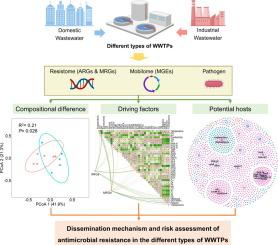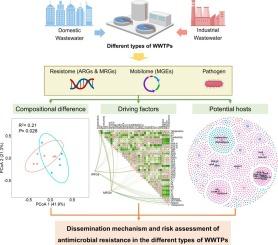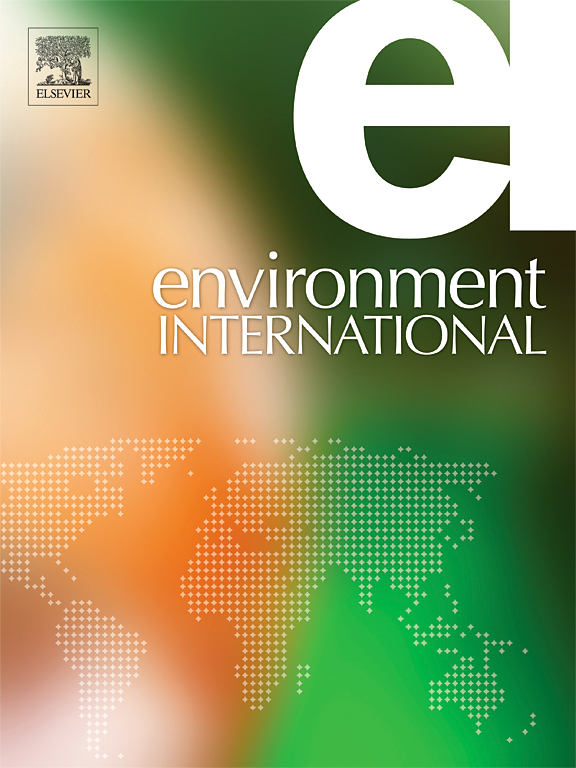The variation of resistome, mobilome and pathogen in domestic and industrial wastewater treatment systems
IF 10.3
1区 环境科学与生态学
Q1 ENVIRONMENTAL SCIENCES
引用次数: 0
Abstract
Wastewater treatment plants (WWTPs), including both domestic and industrial facilities, are key contributors to antibiotic resistance genes (ARGs) and human pathogens in the environment. However, the characteristics and dissemination mechanisms of ARGs in domestic (SD) and industrial (SI) wastewater treatment systems remain unclear, leading to uncertainties in risk assessment. Based on metagenomic analysis, we observed significant differences in the compositions of resistome (ARGs and metal resistance genes, MRGs), mobilome (mobile genetic elements, MGEs), and bacterial community between SD and SI. SI exhibited lower diversity of ARGs but higher abundance of MRGs compared to SD. The removal efficiency of resistome was lower in the SI than that in the SD. MGEs emerged as the primary driver of ARG dissemination in the WWTPs, followed by the bacterial community. Environmental conditions (physicochemical parameters, heavy metals, and antibiotics) indirectly influenced the variation of resistome. Significantly, environmental conditions and MGEs highly influenced the composition of resistome in the SI, while bacterial community more associated with resistome in the SD. Additionally, we identified 36 human bacterial pathogens as potential hosts of ARGs, MRGs, and MGEs in wastewater samples. This study provides new insights on the dissemination mechanisms and risk assessment of antimicrobial resistance in the different types of WWTPs.


生活污水和工业废水处理系统中抗性组、动员组和病原体的变化
污水处理厂(WWTPs),包括生活和工业设施,是环境中抗生素耐药基因(ARGs)和人类病原体的主要来源。然而,ARGs在生活(SD)和工业(SI)污水处理系统中的特征和传播机制仍不清楚,导致风险评估的不确定性。根据采样收集和元基因组分析,我们观察到,SD 和 SI 的抗性组(ARGs 和金属抗性基因,MRGs)、移动组(移动遗传因子,MGEs)和细菌群落的组成存在显著差异。与 SD 相比,SI 的 ARGs 多样性较低,但 MRGs 的丰度较高。SI中抗性基因组的清除效率低于SD。MGEs是污水处理厂中ARGs传播的主要驱动力,其次是细菌群落。环境条件(理化参数、重金属和抗生素)间接影响了抗药性组的变化。值得注意的是,在污水处理厂中,环境条件和微生物基因组对抗药性组的组成影响很大,而在污水处理厂中,细菌群落与抗药性组的关系更大。此外,我们还发现了 36 种人类细菌病原体可能是废水样本中 ARGs、MRGs 和 MGEs 的宿主。这项研究为不同类型污水处理厂中抗菌素耐药性的传播机制和风险评估提供了新的视角。
本文章由计算机程序翻译,如有差异,请以英文原文为准。
求助全文
约1分钟内获得全文
求助全文
来源期刊

Environment International
环境科学-环境科学
CiteScore
21.90
自引率
3.40%
发文量
734
审稿时长
2.8 months
期刊介绍:
Environmental Health publishes manuscripts focusing on critical aspects of environmental and occupational medicine, including studies in toxicology and epidemiology, to illuminate the human health implications of exposure to environmental hazards. The journal adopts an open-access model and practices open peer review.
It caters to scientists and practitioners across all environmental science domains, directly or indirectly impacting human health and well-being. With a commitment to enhancing the prevention of environmentally-related health risks, Environmental Health serves as a public health journal for the community and scientists engaged in matters of public health significance concerning the environment.
 求助内容:
求助内容: 应助结果提醒方式:
应助结果提醒方式:


